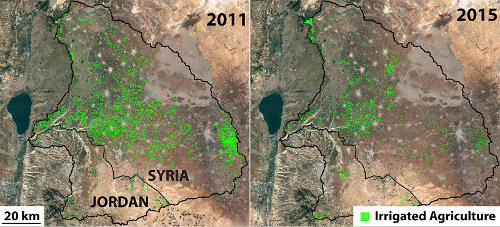The Missing Kingdom: Why Fungi Must Be Central to Conservation Strategy
28 December 2025
Published online 12 December 2016
Refugee exodus reshapes the Syrian hydrological landscape.

© TerraMetrics / Google
Enlarge image
Using remote data such as satellite imagery, researchers based in the US and Canada have now shown that the flight of Syrian refugees since 2013 has dramatically changed water-use patterns and led to an increased water flow into Jordan through the Yarmouk River.
The study was spurred by an anomalous pattern in data from Jordan’s Ministry of Water and Irrigation, noticed by Stanford researchers working on the Jordan Water Project. “We had noticed a sharp increase in the flow rate of the Yarmouk in 2013, bringing more water in from Syria,” says Stanford’s Marc François Müller, who led the study. “We couldn’t really gather direct data because of the war in Syria.”
The timing of the change suggested it might be connected with the flight of refugees, which peaked in 2013, but the team needed data to confirm the link. Without access to direct measurements from Syria, they turned to remote sensing techniques, combining spatial and statistical analyses of satellite imagery with water balance calculations to estimate the changes in irrigation patterns and reservoir usage in southwest Syria.
“The challenge in using remote sensing data is that it rarely actually measures the thing that interests you,” says Mac McKee, director of the Utah Water Research Lab at Utah State University, who wasn’t involved with the study.
Researchers therefore have to find ways of using the data to infer the information they’re after.
“In this case, they’ve done a very impressive job of devising ways of interpreting the data to make quantitative statements of water volumes that can support conclusions about the hydrologic consequences of human activities," explains McKee.
The analysis by Müller and his colleagues1 revealed striking changes in water use. Using data from the Israeli-occupied Golan Heights and the Jordanian side of the Yarmouk river basin for comparison, they showed that the amount of irrigated land and stored reservoir water in southwest Syria after 2013 was reduced by half. When the team repeated the analysis using a cut-off date of 2011 (when the conflict started), the difference between Syria and the other regions was no longer significant, confirming that the changes were due to refugee flight rather than other consequences of the war.
While the end of a regional drought is partly responsible for the increased flow of the Yarmouk, the analysis showed that decreased water use in the Syrian part of the river basin accounts for roughly half of the 340% increase in transboundary flow.
Despite the increased flow, “it’s important not to infer that the war in Syria is good news for Jordan,” warns Müller. Jordan is one of the most water-poor countries in the world, and the modest increase is hardly enough to offset the demands of hundreds of thousands of refugees.
McKee, who has worked in more than 30 developing countries, notes that the methods and approaches used in the study aren’t new. “Their clever assembly begins to address a geopolitical issue in a very new way.” According to McKee, the study shows how basin-level changes in water resources resulting from large-scale human tragedies can be systematically understood, offering hope that they might be better managed in the future. “We can only hope that the water management institutions that must deal with this tragedy will pay attention and learn something.”
“We’ve known that water has an impact on conflict, and now we know that conflict has an impact on water,” says Müller, who is now an assistant professor at Indiana’s University of Notre Dame. “There's a kind of cycle, a feedback, and it will be important to learn whether these feedbacks are positive or negative and how that affects water resources management at different scales. That will be an interesting question for future studies.”
doi:10.1038/nmiddleeast.2016.221
Stay connected: